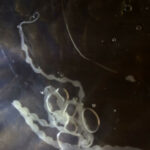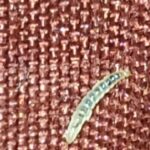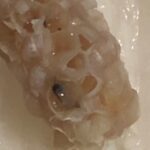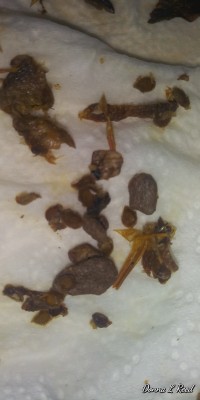Tapeworm can infect any mammal, including humans, although at least in the United States it is more commonly noticed in pets and livestock. There are several types of tapeworm, many of which are host specific, such as fish-specific tapeworms and pig-specific tapeworms. Human tapeworms infestation is most commonly found in regions where there is either fecal contamination of the soil or water supply, or where flesh is eaten raw or barely cooked.
Tapeworm takes full advantage of the parasitic relationship from start to finish. Tapeworms start life in the tail segment of an adult tapeworm. The adult will have attached itself to the wall of the intestine of the host, such as a dog, cat, cow or pig. Attached by the head segment, the tapeworm has also a small neck segment, and then several tail segments. An adult tapeworm is usually six inches longer or more, and fish tapeworms which infect humans can typically reach three to seven feet, and have been known to grow as long as thirty feet long inside their host. The full length of the tapeworm, aside from the head and the neck, is made up of the tail segments (known as proglottids), each of which, when passed out of the host, can infect another new host and start the cycle all over again.
A good example of the tapeworm life cycle is that of the tapeworm found in dogs. The initial infestation in the dog’s intestinal tract will have come from the dog ingesting a flea which was itself infested with tapeworm. Once the tapeworm attaches itself to the dog’s intestine, it begins to create and shed the tail segments (proglottids). By the time the tail segment is shed, it contains tapeworm eggs. Once shed, the tail segment is ejected out the dog’s anus. When a pet with tapeworm gets up from a sitting or laying down position, it will leave behind these tail segments, which look like small writhing pieces of rice. This is now an egg sac, which will eventually dry up and burst, releasing the tapeworm eggs.
Because the host is a dog, there are likely to be fleas in proximity of the tapeworm eggs. This means there is going to be flea larvae. Flea larvae eat whatever organic matter they can find on the surface on which they have been deposited, and this includes tapeworm eggs.
As the larval flea develops into an adult, so too inside it does the larval tapeworm. By the time the flea is an adult, the tapeworm inside it is ready to infect a mammal. When the dog ingests a flea during grooming or other activity, the flea is digested, the tapeworm is released, and the cycle starts all over again as the tapeworm attaches itself to the dog’s intestine.
Fortunately, tapeworm can be easily treated by either tablet (for humans or pets) or injection (for pets). If you think that your pet may have tapeworm, take them to see your vet. If you think that you may have tapeworm, see your doctor.
Recommended reading (click on the picture for details):
All About Worms is always free, always reader-supported. Your tips via CashApp, Venmo, or Paypal are appreciated! Receipts will come from ISIPP Publishing.
















